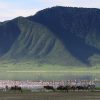Explore Mind-Blowing Ancient Ruins Of Siwa
Siwa Oasis, one of Egypt’s outstanding western desert oases, is located about 350 miles east of the Libyan border and is home to hundreds of palm trees and stunning hot springs. It was cut off from the rest of the nation until the 1980s when a motorway connecting it to the coastal town of Mersa Mahruh was finally finished. The internet has just recently been developed, and technologies like television and phones are very new.
The number of hotels in the oasis is growing, ranging from low-cost hostels to a 5-star eco-lodge, and the tourism industry is now firmly established as a component of the local economy. Yet, this has not been able to change the fundamentals of Siwa’s life. Siwa is still a highly traditional town today, thus it is advised that tourists respect its cultural traditions. Although is quite friendly to tourists, alcohol is prohibited, and Siwan ladies are rarely seen outside of their homes. The languid pace of life is also highly intoxicating. Up until 1926, the entire inhabitants of the oasis resided in Shali, a mud-brick castle from the 13th century that was destroyed by a 3-day rain storm.
Being its ancient and secluded location Siwa is full of places that give us a peep into the past. In this article we have covered everything you need to know about Siwa so read it until the end. Before we begin here are a few things you must keep in mind before visiting Siwa.
Everybody Must Modestly Dress and Respect Local Culture
Siwa is a very welcoming city, although both men and women should take care to respect local customs by dressing correctly. Cover your legs and upper arms. Ladies might expect some extra attention when swimming at any of the public springs, including the well-known Cleopatra’s spring. The desert hot springs are best suited for swimming if you want to avoid attention. You can customize your Egypt tour packages from UAE with us to get the best time exploring Siwa.
Best Time To Visit Siwa
In Siwa, the sun never stops shining and the temperature is almost always pleasant. Nonetheless, there are some seasons of the year when visiting Siwa may not be preferable. As the summers in Siwa can be extremely hot, it is best to travel there in the milder months of the year, from October to April. Although there are many retreats and stays in Siwa that offer stay in traditional structures which stay cool even in hot summer months. You may get a unique experience by visiting Siwa during this period. Don’t forget to include a visit to Siwa in your trip to Egypt from Dubai to get the best time.
Now let us come back to the main topic
Here is a list of the Best ancient ruins in Siwa that are worth visiting. However, if you want tips for exploring ancient ruins in Egypt and Siwa head to our blogs where we have covered the topic.
Shali Fortress
Shali fortress is a very famous tourist spot today in Siwa. Although a few decades back it was a permanent resident of most locals in the oasis. But a 3-day rain storm in 1926 melted this entire mud fortress. The complex of mud-brick houses that makes up the fortress was constructed on a hill inside a protective wall that was originally broken by a single gate. It provided shelter for the inhabitants of the oasis for almost eight centuries. The occupants had to share their animals, which were herded inside the stronghold each evening while they lived in the cramped quarters. However, rain has proven to be more devastating to the stronghold than any human invaders, even though large chunks of salt from Siwa oasis were utilized in its construction to fortify the wall. Don’t forget to include a visit to the Shali fortress in your customized group trips in Dubai.
Gebel Al Dakrur
All sites in the oasis can see Gebel Al Dakrur, which is only a few miles south of Shali. Its triple peaks make it a handy landmark while travelling east or west. This mountain’s summit offers an amazing outlook. Siwa Oasis Sand Treatment Three doctors in Dakrur are well known for treating rheumatism and arthritis with sand remedies. During the warmest month of the year, a sand bath is taken ( July through September). People travel to Siwa oasis for treatment from as far afield as Sweden and Germany. At one of the Clinics at the foot of the mountain, they reside.
To allow the sun to heat the region, workmen create shallow graves in the sand along the slopes early each morning. The patient is moved from the hollow at midday when the sun is at its strongest and covered with more hot sand; less hot sand is piled in the area around the heart, where the patient is asked to drink herbal teas and chicken soup. The treatment lasts for five to seven days, during which time the patient is not allowed to take a bath or consume any cold beverages. Medical treatments can be the number one reason for many people to include visiting Siwa in their Dubai to Egypt tour packages. One good thing about booking your trip with Yup Africano is that we give you complete freedom and flexibility to customize your trip, and this is one of the main reasons why Yup Africano is amongst the best company to plan a customized tour.
The Temple Of The Oracle
It is a magnificent temple. The temple of Amun or Oracle was constructed during the 26th Dynasty, and both the temple and its oracle were prosperous during the Greek and Roman eras. The temple was constructed on top of a mountain, and visitors can access its remains by following a designated path up the rock face.
Another tradition attributes the construction of the temple to the Greek god Dionysus, while one claims that Danaus the Egyptian constructed it in honour of Ham, the son of Noah. When a ram appeared and led Dionysus to the spring of Agroumi as he was about to pass out from thirst, Dionysus built this temple as an act of gratitude. Visit this iconic place by including Siwa in your Egypt packages from Dubai.
Gebel Al- Mawta
A little more than a kilometre to the north of Shali is the conical peak known as Gebel Al Mawta or the Mountain of the Dead. Four tombs at Gebel Al- Mawta are worth seeing. They are cut into the side of the mountain and date from the Ptolemaic, Roman, and 26th Dynasty periods.
Tomb of Niperpathot
Large and among the oldest tombs in the oasis, the tomb of Niperpathot dates very probably from the Twenty-sixth Dynasty. On the Mountain, there is a court with three tombs. Niperpathot was the scribe of the dive records and an Osiris prophet.
Temple Of Umm Ubaydah
Due to the dynamiting of this building in 1896 by an Ottoman administrator seeking building materials, it is almost completely demolished. All that is left to be seen is an inscribed wall. Nonetheless, researchers have concluded that the temple was built by the pharaoh Nectanebo of the 30th Dynasty based on previous sketches made by pioneer explorers. And it is a great site to take glimpses of Siwa’s history.







